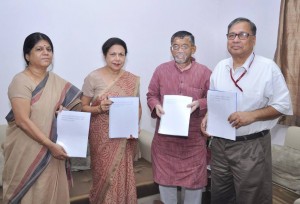35 Million Additional Jobs to be Created
Shri Santosh Kumar Gangwar, Minister of State for Textiles (I/C) on July 28 received the draft Vision, Strategy & Action Plan for Indian Textiles & Apparels presented by Shri Ajay Shankar, Chairman, Expert Committee & Member Secretary, National Manufacturing Competitiveness Council (NMCC).
Vision 2024-25
Over the last 10 years, India’s textile and apparel exports have grown at the rate of 11%. After the phasing out of export quotas in 2005 India’s export performance has been below expectations.

The Chairman, Expert Committee and Member Secretary of the National Manufacturing Competitiveness Council, Shri Ajay Shankar presents Vision, Strategy and Action Plans for Indian Textile and Apparel sector to the Minister of State for Textiles Shri Santosh Kumar Gangwar, in New Delhi on July 28, 2014. The Secretary, MoT, Zohra Chatterji is also seen.
Vietnam and Bangladesh have shown remarkable success. Vietnam could achieve a peak export growth rate of 30% while Bangladesh could achieve a growth rate of 18%.
There is no reason why India, provided it takes the necessary steps, cannot achieve 20% growth in exports over the next decade. In the domestic market, sustaining an annual growth rate of 12% should not be difficult.
This implies that with a 12% CAGR in domestic sales the industry should reach a production level of US$ 350 billion by 2024-25 from the current level of about US$ 100 billion for the domestic market.
With a 20% CAGR in exports India would be exporting about US$ 300 billion of textile and apparel by 2024-25. India should by then have a market share of 20% of the global textile and apparel trade from the present level of 5%.
During this period India should attempt a structural transformation whereby it exports only finished products. This would imply that growth rates in exports of fibre and yarn start declining and growth rates of apparel, homes furnishing, technical textiles and other finished products should grow very rapidly. This would maximise employment generation and value creation within the country. In the process, investment of about US$ 120 billion would take place and about 35 million additional jobs would get created.
Keeping in view the various changes in the textile industry on the domestic and international fronts and the need for a road map for the textile & apparel industry, MoT had initiated the process of reviewing the National Textile Policy 2000. Accordingly, an Expert Committee was constituted including leading industrialists from the textile sector to make fresh recommendations. The draft Vision, Strategy and Action Plan 2024-25 has been submitted after a detailed process of stakeholder consultations across the entire value chain.





